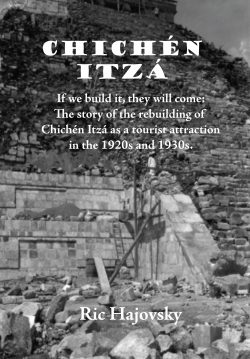
This new, softbound book tells the true story of how and why many of the Maya buildings at Chichén Itzá were rebuilt rather than restored in the 1920s and 1930s through an amazing collection of nearly 200 historic photographs. These images, a number of which have never been seen before by the public, show how some of the site’s temples (the Ball Court’s Upper and Lower Temples of the Jaguar, the Venus Platform, the Platform of the Eagles and Jaguars, as well as others) were redesigned and rebuilt nearly from scratch with the goal of creating a money-making tourist attraction. The book guides the reader through the early planning and development of the scheme, with excerpts from the Mexican government and the Carnegie Institute’s correspondence showing their collusion to create a tourist magnet of the archaeological zone by “enhancing” the ancient Maya architecture found there.
One section of detailed images in the book shows the gradual rebuilding of El Castillio pyramid in the 1920s, beginning with an overgrown rubble mound and ending up with a crisp, clean new pyramid covered on two sides by newly cut limestone. In the series of images, the reader can see the progress being made as the scaffolding rises over the new stone and more blocks are cut and carried up to lay in place for the next course. This section also explains how the number of steps on each side was changed twice during the rebuilding, first to 103 and later to 91, with neither number agreeing with the written accounts of early visitors and trained archaeologists. Another section of the book explains (and shows in historic before-and-after photographs) how this rebuilding is the true cause of the equinox’s serendipitous “shadow on the stairs” phenomenon, not a well-engineered plan executed by early Maya builders. Lately, the National Institute of Anthropology and History (INAH) has distanced itself from this tourist promotion that they began in the 1970s. The official Mexican government website of INAH explains it as follows: “The serpentine solar projection that runs along the north balustrade of El Castillo in Chichén Itzá during the spring and autumn equinoxes and which attracts thousands of visitors to the Chichén Itzá archaeological zone is actually a recent archaeoastronomical myth.”
Other sections of the book address commonly repeated myths regarding virgin sacrifices, the echo of a clap at El Castillo, and the beheading of the winner (or loser) of the ball game. Explanations from archaeologists in these sections tell what actually went on at the Ball Court and the Sacred Well, in addition to explaining the science behind the echo.
The book is an entertaining eye-opener, full of images and quotes from documents that will change forever the way you view Chichén Itzá.
